Japan
Wood Products Prices
Dollar Exchange Rates of 10th
November
2019
Japan Yen 108.88
Reports From Japan
Hopes for growth pinned on domestic consumption
The Cabinet Office¡¯s gross domestic product (GDP)
figures show annualized 0.2% growth in the third quarter
of 2019, far short of expectations. There could have been a
decline if it was not for the surge in personal spending
ahead of the October increase in consumption tax. The
third quarter slowdown is in contrast to the 1.8%
expansion in the second quarter.
Before the tax increase, consumers rushed to buy home
appliances and daily necessities. Consumer spending
accounts for more than half of Japan¡¯s GDP, and any
slowing of consumption would cast doubt on the Bank of
Japan¡¯s optimism that robust domestic demand will offset
the impact of the global economic slowdown.
The disappointing news was that exports fell by nearly
1%, mainly because of a slowdown in machinery
shipments to China.
Big spending on infrastructure to feature in
supplementary budget
To speed recovery in areas hit by recent natural disasters
and to cope with other risks to the economy, such as the
China¡ªUS trade row and the UK¡¯s exit from the EU, the
government will earmark funds in a supplementary budget
for fiscal 2019, which ends in March 2020.
This will be the first such financial package in three years,
and spending on reconstruction work will address
damaged roads, bridges, river embankments, homes and
farming facilities. The local timber trade is already
anticipating huge demand for wood products, and this
could lead to a rise in plywood imports, which have fallen
sharply this year.
Economy steady after tax hike, but companies holding
back on investment
According to a Reuters poll, most Japanese companies say
the impact of the latest rise in consumption tax has not
resulted in a steep downturn in consumer consumption,
which was very pronounced when the tax was raised five
years ago.
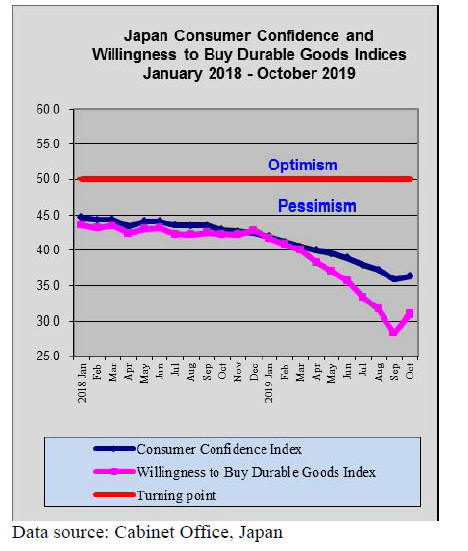
The consensus amongst economists is that the Japanese
economy looks likely to avoid a drop in private
consumption thanks to the measures introduced by the
government to soften the impact of the tax.
Despite the positive signs, the majority of Japanese
companies remain cautious about investing, saying there is
little chance of big pay increases next year.
Is Bank of Japan about to change course? Risk of
stronger yen worries exporters
At a recent meeting with the media, the Governor of the
Bank of Japan (BoJ) welcomed the government¡¯s plan for
a supplementary budget, saying that a mix of fiscal and
monetary stimulus could help the country attain its
inflation target.
Analysts were quick to pick up on these statements
as
seeming to imply that monetary policy alone is not
working. From the beginning, many analysts doubted that
the 2% inflation target was attainable, a view also held by
some Japanese bankers and academics.
What comes next is a major question. If the BoJ changes
course, it could have a huge impact, say analysts. For
example, it could lead to a surge in the yen on a wave of
¡°safe haven¡± buying, which would jeopardize the
performance of exporters and undermine growth.

Sporty wood-cellulose car at Tokyo motor
show
Visitors to the Tokyo Motor Show 2019 had the
opportunity to see how eco-conscious designers tackle the
motor industry. With funding from the Ministry of the
Environment, a team from the University of Kyoto built a
sporty ¡°nano cellulose vehicle¡± (NCV) with the aim of
reducing the weight of cars to achieve better fuel
efficiency and thus a reduction of CO2 emissions.
The nanofibres used were from cellulose extracted from
trees through pulping and fibrillation; they were mixed
into a resin for moulding.
See: https://www.city-cost.com/blogs/City-Cost/GQPxLliving_
sustainablelife_tokyo
Import update
Wooden door imports
The value of Japan¡¯s imports of wooden doors
(HS441820) dipped in August and dropped further in
September this year by around 6%. Compared with a year
earlier, September imports were flat.
As in previous months, the top two shippers, China and
the Philippines, accounted for more than 80% of arrivals.
The other small but significant shippers in September were
Indonesia and Malaysia.¡¡
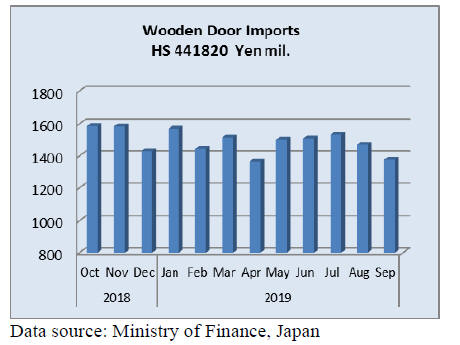
Wooden window imports
The value of wooden window (HS441810) imports
dropped in September by 10%, month-on-month, but
imports were flat to September, year-on-year. The top
shippers in September were China (60% of imports) and
Indonesia (19%).
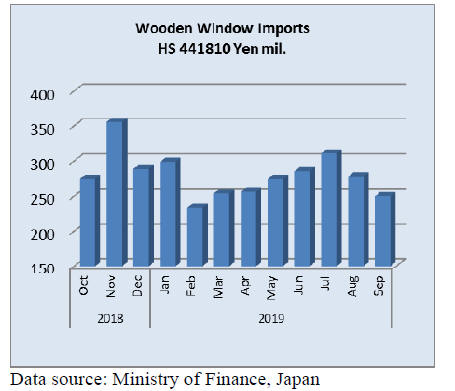
Assembled wooden flooring imports
The value of Japan¡¯s assembled wooden flooring imports
traditionally see-saw between peaks and dips. The dip in
imports in August and September, however, has not been
observed before.
Wooden flooring imports (HS441871-79) in September
2019 were down by 22%, year-on-year, and by 15%,
month-on-month.
The bulk of August¡¯s assembled wooden flooring imports
were of HS441875; the main shippers in September were
China and Indonesia.
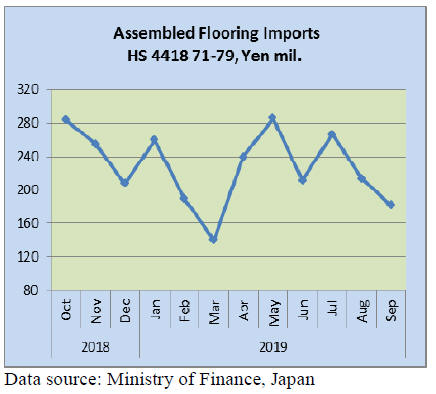
Plywood imports
As in previous months, HS 441231 dominated Japan¡¯s
plywood imports. It accounted for over 80% of all
plywood imports by volume in September, most of which
was shipped by suppliers in Malaysia and Indonesia.
Year-on-year September plywood arrivals from Malaysia
were down a further 23%. Imports from Malaysia in
January this year were over 90,000 cu.m but by September
had fall to just 50,000 cu.m. Shipments from Indonesia are
holding up better¡ªflat, year-on-year, and down only 10%,
month-on-month.
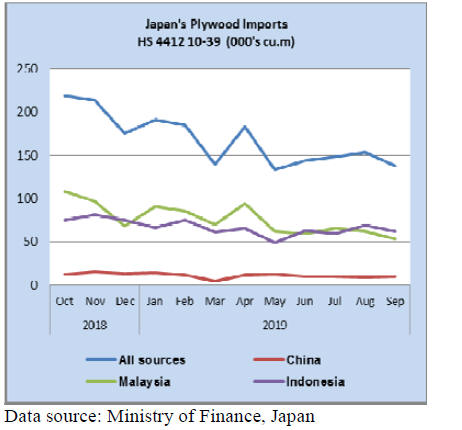

Trade news from the Japan Lumber Reports
(JLR)
The Japan Lumber Reports (JLR), a subscription trade
journal published every two weeks in English, is
generously allowing the ITTO Tropical Timber Market
Report to reproduce news on the Japanese market
precisely as it appears in the JLR.
For the JLR report please see:
http://www.n-mokuzai.com/modules/general/index.php?id=7
Log supply drops by typhoon damages
Typhoons hit Tokyo and North one after another since last
September and the Ministry of Agriculture, Forestry and
Fisheries reported total damage as of October 29 is
estimated about 126.8 billion yen out of which damages
on forestry is 38.7 billion yen. Many farm products were
damaged right before harvest then heavy rains ruined
logging road system by land-slides and flood.
Disruption of road system hampers hauling of harvested
logs so that log supply is getting declining. This is time for
sawmills to buy and accumulate fresh fall cut logs to
replace summer cut logs with heavy moisture content so
mills¡¯ log inventory is low so without such incident, log
prices should be firming seasonally but logs are not
available as sawmills want so that log prices are climbing.
Lumber market of structural materials of post and beam
for housing has not changed much and stays almost flat
while there are increasing demand for materials such as
furring strip, low priced board and batten for repair works
of typhoon damaged houses.
Since logging road repair takes time, log supply will
continue tight so the log prices will stay up high. Because
of unchanged slow lumber market and climbing log prices,
some sawmills consider to curtail production.
Wood demand projection meeting
The Forestry Agency held the second wood demand
projection meeting in late September. Forecast of new
housing starts by 13 think tanks for 2020 is average of
870,000 units while the forecast for 2019 is 893,000 units.
Only four think tanks forecasted over 900,000 units and
the lowest forecast is 810,000 units.
Reason of pessimistic forecast is slowdown of world
economy and Japanese economy will be influenced. The
forecast is revised downward from previous forecast so
that import of logs, lumber and plywood is also revised
downward for the fourth quarter of 2019. The first quarter
forecast of imported logs and lumber would decrease
compared to the same quarter this year.
By declining demand, import of logs and lumber would
continue decrease next year. Domestic log demand for
lumber would decrease but for plywood the demand would
increase.
Radiata pine logs and lumber from New Zealand and Chile
would decrease because of depressed crating lumber
market affected by trade friction between China and the
U.S.A.
Domestic plywood supply will increase by new plywood
mills coming on stream so the first quarter 2020 would
increase but imported plywood supply would stay
unchanged from 2019. On structural laminated lumber
supply, domestic supply would decrease for the fourth and
first quarter but supply of imported lumber would increase
due to lower prices.
Plywood
Domestic softwood plywood business continues active
while imported South Sea hardwood plywood business is
stagnating.
Shipment of domestic softwood plywood to precutting
plants are very busy so that the inventories by
manufacturing mills are low. The manufacturers¡¯
production is full now and any additional production is
difficult because of tighter working rules, which makes
overtime and weekend operations difficult.
In early August, one plywood mill¡¯s long panel production
line stopped by mechanical trouble so other mills
increased long panel production, which reduced
production of 12 mm structural panels so the inventory of
standard panel became tight. In fall, trucks are hard to get
because it is harvest season and many trucks are taken to
transport farm products like rice so deliveries are delayed
by a week to ten days but precutting plants runs without
much problem so far.
Series of typhoon hit Eastern Japan in last two months,
which damaged many houses by flood and landslide so
orders are increasing for plywood for repair works. With
labor shortage for rehabilitation works, such demand
would continue long period of time.
Movement of South Sea hardwood plywood is stagnating
with small orders particularly for concrete
forming panel but after typhoons¡¯ damages, there are more
orders for temporary shelter materials so the prices seem
to be hitting the bottom and if this move continues, the
prices may go up.
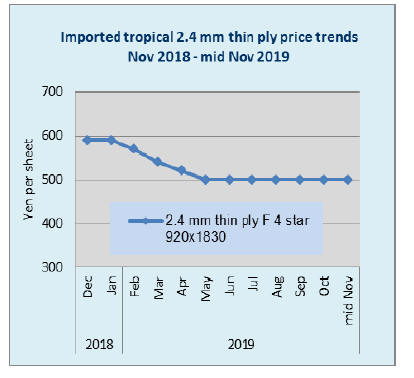
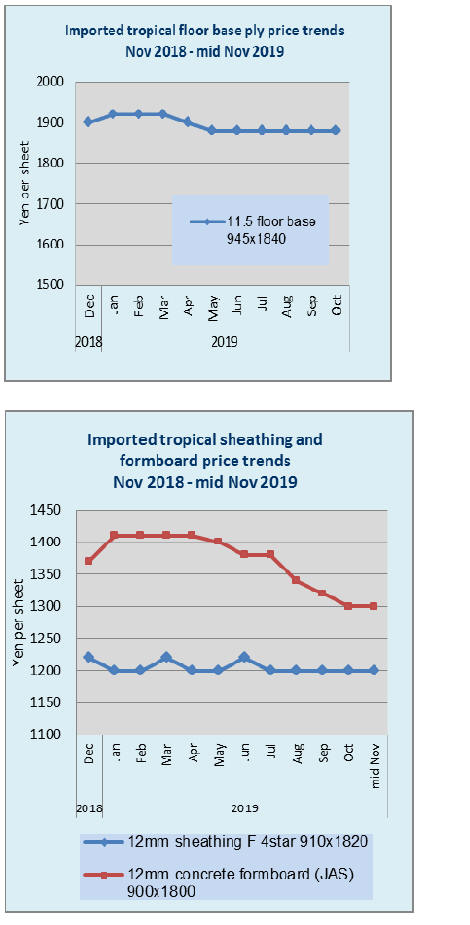
Impact of TPP and EPA
TPP (Trans Pacific Partnership) agreement became
effective in December 2018 and EPA (Economic
Partnership Agreement) with EU countries did in February
2019. By these agreements, import duty on Canadian SPF
lumber is reduced from 4.8% to 2.4% and that on OSB is
reduced from 5-6% to 2.5% -3% and after 16 years, both
will be abolished to zero %.
On EU¡¯s SPF lumber with 4.8% duty, structural laminated
lumber with 3.9% and OSB and particleboard with 5.0-
6.0%, duty rate will be reduced by 0.3-0.8% every year for
seven years and will become zero after 16 years.
Malaysia, one of participating country, has not completed
procedures but after it is done, tropical logs and hardwood
plywood duty of 6-10% will be reduced to 3-5% and be
zero after 16 years. The Japanese government allocated
large amount of budget to protect domestic wood industry
since reduction of import duty will make foreign products
more competitive and become threat to domestic wood
industry and would cause shrinkage of domestic wood
demand.
In 2015, 29 billion yen of budget was spent for
strengthening lumber and plywood industry. In 2016, 33
billion yen and in 2017, 40 billion yen then in 2018, 39.2
billion yen were allocated. This budget was spent to
subsidize building of lumber, plywood and laminated
lumber plants with necessary machines and introduction of
harvesting machines for forest unions and log suppliers,
which feed necessary logs to processing plants and also
preparation of logging road system.
During 2009 and 2014, total of 373.4 billion yen were
allocated to subsidize renewing sawmill facilities and
enlarging production capacity and this ensured supply
capacity and stable quality of domestic wood products.
Also this promoted shifting of raw materials from
imported wood to domestic wood. Also with help of the
subsidy, new large lumber mills and plywood mills were
built in prefectures, which did not have such production
facilities before.
Producing mills actually moved into where there is little
competition of log procurement. This move also helps
spread out producing facilities in many areas and this
guarantees stable supply when natural disasters like
typhoon, flood and earthquake hit certain area, which
damage producing facilities in the areas.
Actually there have been such disasters every year
recently but by increasing supply capacity outside
damaged areas, it guaranteed stable supply of domestic
wood products.
By constant enforcement of domestic wood industry in last
several years, self-sufficiency rate has been improving.
Actually it is result of decrease of imported logs and
lumber in 2017 and 2018 while domestic wood products
increased.A
Before import duty reduction starts by these agreements,
Canadian SPF lumber and European structural laminated
lumber are more competitive by drop of supply prices due
to depressed own markets and this stopped the move of
shifting to domestic wood like SPF lumber. On plywood,
structural panel is now mainly all domestic but floor base
is mainly relying on tropical hardwood plywood yet.
SPF lumber
Import duty is reduced from 4.8% to 2.4% after TPP
became effective since December 31, 2018. At the first
quarter price negotiations, duty reduction was not much
issue since the export prices of J grade has been dropping
largely from the peak prices of US$ 700 per MBM C&F in
the third quarter in 2018. The market prices have been
nosediving much larger than duty reduction.
The first quarter prices in 2019 were down to US$560 then
price drop continued after the first quarter by US$50 and
US$30 and the third quarter prices were US$490-500,
30% drop from the peak. Therefore, the focus is difference
between domestic lumber prices in the North America and
J grade prices.
Regardless of import duty, Canadian SPF lumber prices
would change by other factors. By anti-dumping duty and
countervailing duty on softwood lumber exported to the
U.S.A. since 2017, break even prices of Canadian sawmill
moved up then log prices climbed by tight supply as
annual allowable cut in B.C. is largely reduced after
extensive mountain beetle damaged lodge pole pine timber
harvest was done.
With these factors, J grade prices would be higher in
future together with another climbing factor of higher
ocean freight by switching to use low sulfur oil by law
since 2020.
European lumber
Between EU and Japan, after EPA became effective,
import duty of 10 items of wood products will be reduced
step by step and totally abolished in 2025. Present rate is
2.9% on laminated lumber, 3.6% on lumber and 4.5% on
wooden board. Compared to before EPA, reduction of
duty is 1.0% on laminated lumber, 1.2% on lumber and
1.5% on wooden board.
Gradual reduction is to alleviate excessive impact to the
market by immediate abolishment. This is the second year
after the agreement became effective but there is no
impact to the market because suppliers¡¯ prices dropped by
slump of worldwide market and the exchange rate moved
from 130 yen plus in 2017 and 2018 to 118-119 yen per
Euro now.
This reduces the yen cost. When the agreement started,
reduction of import duty reduces imported cost so it makes
European products more competitive but now the prices
for the fourth quarter on lamina are Euro 220 per cbm
C&F and on redwood laminated beam and whitewood
laminated post, the prices are down to less than Euro 400.
These price level is unprofitable for the supplying mills
and some Scandinavian mills plant to curtail the
production.
Duty reduction helps compete European lumber to
domestic cedar laminated lumber. Present cedar laminated
post prices are 1,750 yen per piece delivered and
whitewood laminated post prices are down to about 1,800
yen so they compete to get more market share now.
Plywood and wooden board
Import duty reduction by TPP and EPA does not give
much impact on competition between domestic products
and imported products. Rate of duty reduction varies by
items but the maximum reduction is 5%. On Malaysian
hardwood plywood, export prices has been climbing by
tight log supply while the market in Japan of imported
plywood shows no sign of recovery so duty reduction is no
help.
In short, gap between high export prices and stagnant
market prices in Japan continues and duty reduction is not
large enough to fill the gap.
Also duty reduction rate on Canadian and European OSB
is small and when housing starts in Japan is weak
particularly on rental units, there is no incentive to use
OSB by small duty reduction.
Domestic plywood and imported plywood have been
having different market so even if duty reduction helps
increase supply of imported plywood, there will be very
little influence on domestic plywood market. After the
supply of South Sea hardwood plywood became unstable,
floor manufacturers in
Japan are switching to use domestic plywood.
Chinese wood buyers¡¯ inspection tour
The Japan Wood Products Export Promotion Council
recently held business meeting with four Chinese wood
products buyers and inspection tour of Japanese wood
industry.
The visitors visited Chugoku Lumber and Miyasako
Lumber in Hiroshima prefecture and Meiken Lamwood,
Yamashita Lumber and Innosho Woods in Okayama
prefecture. The business meeting was held in Okayama
city together with export promotion seminar.
The Council arranged one week tour for the visitors for
touring various wood products manufacturers, which are
anxious to export the products to China and exchanged
information.
At the Japanese wood products export promotion seminar,
four Chinese buyers individually made lecture about
Chinese wood products market. Log import by China for
the first half of 2019 was about 30,000,000 cbms, 2.5%
less than the same period of last year but softwood logs
and lumber import increased from 2018.
Imported softwood logs and lumber are used for furniture
and interior furnishing. Demand for furniture, children¡¯s
desk and furniture like desk and drawer and casket on
every important occasion of life like wedding, child birth
and funeral and such demand is closely forecasted. Some
buyer plans to specialise Japanese cypress products as
cypress is Chinese favorite species. Another commented
that Japanese cedar prices are competitive and with
expanding Chinese logistics, cedar pallet has better chance
in China.
In China, non-residential wooden buildings like hotels and
library draws much attention recently so that there is more
chance to use wood in China in future. Four Japanese
companies participated business meeting. The group
visited Okayama Prefectural College¡¯s alumni hall, which
is built with 3 and 4 meter 120 mm cypress square.
|